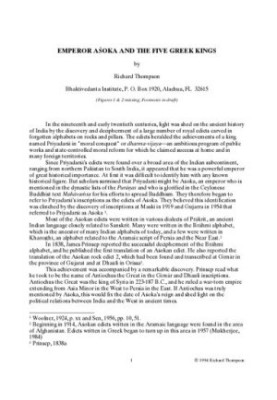Emporer Asoka and the Five Greek Kings
 Instant download
Instant download
after payment (24/7)
 Wide range of formats
Wide range of formats
(for all gadgets)
 Full book
Full book
(including for Apple and Android)
In the nineteenth and early twentieth centuries, light was shed on the ancient historyof India by the discovery and decipherment of a large number of royal edicts carved inforgotten alphabets on rocks and pillars. The edicts heralded the achievements of a kingnamed Priyadarsi in "moral conquest" or dharma-vijaya⎯an ambitious program of publicworks and state-controlled moral reform for which he claimed success at home and inmany foreign territories.Since Priyadarsi's edicts were found over a broad area of the Indian subcontinent,ranging from northern Pakistan to South India, it appeared that he was a powerful emperorof great historical importance. At first it was difficult to identify him with any knownhistorical figure. But scholars surmised that Priyadarsi might be Asoka, an emperor who ismentioned in the dynastic lists of the Puranas and who is glorified in the CeyloneseBuddhist text Mahavamsa for his efforts to spread Buddhism. They therefore began torefer to Priyadarsi's inscriptions as the edicts of Asoka. They believed this identificationwas clinched by the discovery of inscriptions at Maski in 1919 and Gujarra in 1954 thatreferred to Priyadarsi as Asoka.
LF/79327138/R
Data sheet
- Name of the Author
- Richard Thompson
- Language
- English
- Release date
- 1994








